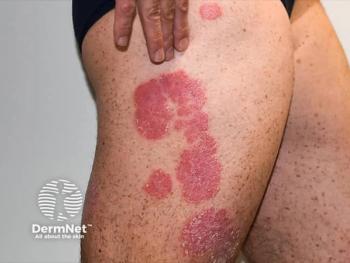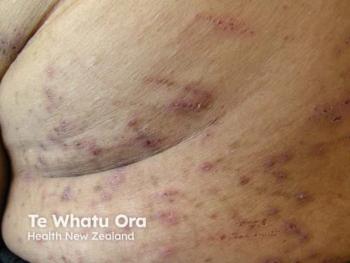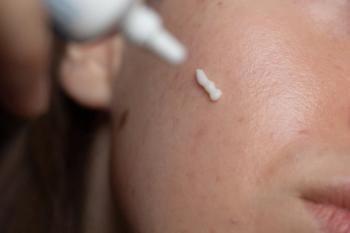
Corvus Pharmaceuticals’ Soquelitinib Shows Rapid, Dose-Dependent Efficacy in Phase 1 AD Trial
Key Takeaways
- Soquelitinib demonstrated a favorable safety and efficacy profile in a phase 1 trial for atopic dermatitis, with the highest dose showing the most significant improvements.
- The investigational drug selectively inhibits ITK, affecting T cell differentiation and reducing inflammatory cytokines, potentially benefiting autoimmune and allergic diseases.
Selective ITK inhibition with oral soquelitinib led to early and durable clinical responses, cytokine reduction, and increased T regulatory cells.
Soquelitinib is an investigational, small molecule oral therapeutic designed to selectively inhibit IL-2-inducible T cell kinase (ITK), an enzyme predominantly expressed in T cells and involved in T cell and natural killer (NK) cell immune function. According to initial data, soqeulitinib has demonstrated its ability to affect T cell differentiation and induce Th1 helper cells while blocking the development of both Th2 and Th17 cells and production of their secreted cytokines. Corvus “believes the inhibition of specific molecular targets in T cells may be of therapeutic benefit for patients with cancers, including solid tumors, and in patients with autoimmune and allergic diseases.”2
“This is the first time that a selective ITK inhibitor has been studied in atopic dermatitis or any human immune-mediated disease for that matter. I think this trial is a real step forward in giving us a potential new way to selectively target TH2 and TH17 with an oral medication with an acceptable safety profile,” said Albert Chiou, MD, MBA, a board-certified dermatologist, clinical associate professor of dermatology at the Stanford University School of Medicine in California, and an active investigator in the development of soquelitinib, in an
Enrollment for all 3 cohorts concluded as of May 6, 2025, and included 48 total patients. The interim phase 1 data highlights 32 patients receiving soquelitinib and 12 patients receiving placebo with a 28-day follow-up, and 4 patients receiving soquelitinib with a 15-day follow-up from cohort 3. The 4 patients in cohort 3 have not completed their 28-day treatment.
“We continue to be encouraged by the results from our phase 1 trial of soquelitinib in patients with atopic dermatitis, which show a favorable safety and efficacy profile with a convenient oral tablet. We believe the results are particularly exciting given the relatively short treatment duration of 28 days and durable post-treatment results, both of which we associate with the novel mechanism of action provided by ITK inhibition,” said Richard A. Miller, MD, co-founder, president, and chief executive officer of Corvus Pharmaceuticals, in the news release.1
Miller continued, “This is supported by biomarker studies from the trial, which show evidence of multiple effects derived from the selective blockade of ITK including the reduction of various inflammatory cytokines and the potential induction of T regulatory cells, further amplifying the disease-modifying effects of soquelitinib. Based on these results, we have amended the trial protocol to evaluate an additional 24 patients at the 200 mg twice per day dose, randomized one-to-one with placebo for an extended treatment period of 8 weeks. This amendment gives us the opportunity to evaluate the potential for even stronger efficacy with longer treatment duration. This additional experience is intended to help optimize the design of a phase 2 trial, which we are on track to initiate before the end of the year.”
Current primary end points include safety and tolerability. Secondary end points include improvements in EASI scores and IGA to measure efficacy. Reduction in itch and various cytokine biomarkers are exploratory end points.
Results
Patients in cohort 3 (n=16) had more severe disease with higher mean baseline EASI scores compared with patients in cohorts 1 (n=16) and 2 (n=16). A higher proportion of patients failed prior systemic therapies. Across the 3 cohorts, the mean EASI scores are 22.3 and 21.1 for active and placebo.
The percent reduction in mean EASI scores at 28 days for cohorts 1 and 2 combined was 54.6% for patients receiving soquelitinib and 30.6% for patients receiving placebo. In cohort 3, the percent reduction in mean EASI score at 28 days was 71.1% for patients receiving soquelitinib and 42.1% for patients receiving placebo.
In cohort 1, 25% of soquelitinib-treated patients achieved IGA 0/1 and 25% achieved EASI 75 after 28 days of treatment. In cohort 2, 17% of soquelitinib-treated patients achieved IGA 0/1 and 33% achieved EASI 75. In cohort 3, 35% of soquelitinib-treated patients achieved IGA 0/1 and 63% achieved EASI 75. No patient receiving placebo achieved IGA 0/1 or EASI 75.
Corvus’ data also revealed relationships between reductions in specific cytokines with improvements in EASI scores. Reductions in serum cytokines were observed in IL-5, IL-9, IL-17, IL-31, IL-33, TSLP, and TARC. According to the announcement, “increasing trends were seen in numbers of circulating T regulatory cells, consistent with the presumed mechanism of action of soquelitinib.”
Safety and Future Outlook
From the interim phase 1 data, soquelitinib was well-tolerated with no dose-limiting toxicities and no clinically significant laboratory abnormalities in any of the cohorts. Additionally, there were no drug dosing interruptions. Treatment-related and unrelated grade 1/2 adverse events were observed in 32.3% of patients receiving soquelitinib and 25% receiving placebo. One treatment-related adverse event of nausea (grade 1) was reported with soquelitinib treatment.
“We believe the data highlights soquelitinib’s potential as a new treatment option for atopic dermatitis and the broader opportunity for ITK inhibition for other immune related diseases. In addition to blocking the production of multiple inflammatory cytokines, soquelitinib may have persistent direct effects on immune cell function that act to regulate aberrant immune responses. We look forward to completing the Phase 1 trial and initiating other trials with soquelitinib for immune diseases,” Miller said in a
In-depth discussions of the data will be presented at the Society for Investigative Dermatology 2025 Annual Meeting in San Diego, May 8 from 4:30-6:00 pm PT and May 10 from 9:50-10:00 am PT.
References
- Corvus Pharmaceuticals announces data from cohorts 1-3 of placebo-controlled phase 1 clinical trial of soquelitinib for atopic dermatitis. Corvus Pharmaceuticals. News release. May 8, 2025. Accessed May 8, 2025.
https://investor.corvuspharma.com/news-releases/news-release-details/corvus-pharmaceuticals-announces-data-cohorts-1-3-placebo - Corvus Pharmaceuticals announces interim data from placebo-controlled phase 1 clinical trial of soquelitinib for atopic dermatitis. Corvus Pharmacetuicals. News release. December 18, 2024. Accessed May 8, 2025.
https://investor.corvuspharma.com/news-releases/news-release-details/corvus-pharmaceuticals-announces-interim-data-placebo-controlled
Newsletter
Like what you’re reading? Subscribe to Dermatology Times for weekly updates on therapies, innovations, and real-world practice tips.


















